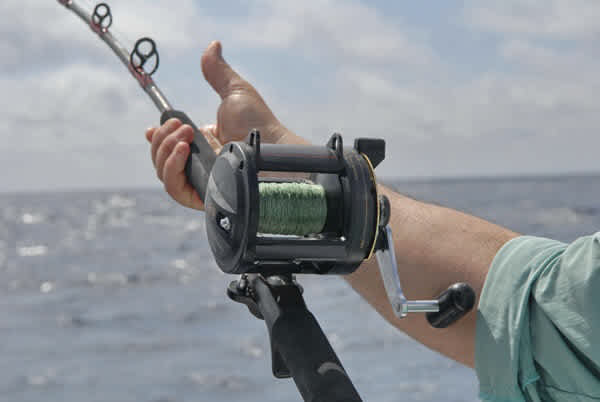Line Matters: Using the Right Lines Can Add to Your Fishing Success
Yamaha 07.12.11

Fishing line is the all-important link between you and the fish. In fact, it’s one of three components you just can’t fish without, a hook, bait (artificial or natural) and line; everything else is optional. Buying line used to be simple when there were only a few brands with familiar names. Today there are dozens of brands, but more importantly, a variety of different types of line that when used for specific applications can add dramatically to your fishing success.

The earliest fishing lines were made by braiding commonly available natural fibers, like cotton, and silk in much the same way sewing thread is made. While they were functional, they deteriorated quickly unless they were cleaned and air-dried after each use to prevent them from rotting. Enter the age of manmade miracle fibers and the introduction of two fishing lines that changed the sport. In 1939, DuPont® developed nylon, which the company eventually marketed in various forms for hundreds of uses from brush bristles to fabrics, but it took almost two decades and the introduction of the spinning reel before it gained general acceptance by fishermen. Dubbed “monofilament” it is made by pushing a heated polymer through a die to extrude the single filament structure we recognize as fishing line. The diameter of the hole in the die is responsible for the diameter of the line, which relates to breaking strength. The composition of the polymer matrix can affect the performance characteristics of the line, such as strength, abrasion resistance, softness, visibility and percentage of stretch. Another new miracle fiber called Dacron,® introduced in the 1940s, replaced natural fibers in braided line and was a big hit with anglers who fished with conventional tackle because it was stronger and didn’t rot.
Both fishing lines are still used today. Dacron® is used almost exclusively for big game trolling on heavy rods and reels or for fly line backing, but even with the advent of a new generation of “super lines,” nylon monofilament line still dominates the market because of its versatility and reasonable cost. It is used in fresh and saltwater on spinning, bait casting and conventional tackle and has benefited greatly from new and more advanced blends of polymers. Thin diameter co-polymer monofilament is a good choice for casting, plugging and light tackle applications. Lines marked as “tough” or extra abrasion resistant are better with heavy spinning outfits or saltwater conventional tackle.
When selecting a color, try to stick with one that matches the environment in which you are fishing. For example, in very clear water, a thin diameter clear monofilament will get more strikes. For murky bay or inshore water, green or smoke color is better, and for offshore ocean water, clear or blue gets the nod. High visibility lines in red or fluorescent yellow are best for trolling when lure placement is critical, but they are used with leaders of clear mono or near invisible fluorocarbon line. Multi-color camo lines offer reduced visibility by blending into the background like a hunter’s camouflage clothing.
One of mono’s most endearing qualities is its elasticity or ability to stretch without breaking, but the percentage of stretch varies from one brand and type to another. The ability to stretch has saved many a fish from breaking off over the years, but it also has a downside, a dramatic reduction in sensitivity between the bait or lure and the fishing rod in the angler’s hands. It also makes setting the hook more difficult when a significant amount of line separates the angler and the fish. These deficiencies have led to the recent popularity of a whole new generation of super braid lines.

Gel spun Spectra® and Dyneema® fibers are stronger by weight than any manmade material and are used in such exotic applications as bullet-proof vests and helmets. However, in recent years they have made quite a splash as fishing line. When braided, the resulting line is limp, incredibly thin and strong, and it has almost no stretch, which means it transmits a clear signal back to the angler’s hand. You can feel the most subtle strike or know exactly when a lure or bait is bumping the bottom or structure, and setting a hook requires little more than a flick of the wrist. This has made them a favorite in saltwater for bottom fishing with bait, using bucktails, all kinds of jigs or pretty much any light tackle technique that benefits from increased sensitivity and quick hook sets. Their thinness lets you pack more and heavier line onto small reels. This has spawned a whole new generation of miniaturized big game reels with high speed gearing and amazing drag systems capable of handling big, hard fighting pelagic fish such as tuna.
These next-generation braided lines are a stand out for inshore trolling because they offer less water resistance, allowing lures to go deeper. Manufacturers of popular deep diving-plugs recommend braided lines to attain the depth capabilities the lures were designed to provide. The thin diameter and low stretch means you can use less weight when bottom fishing and feel even the most subtle strikes hundreds of feet down in the water column. Even surf fishermen who crave extra distance are switching to high-tech braids on their spinning reels, and adding more yards to their casts.
Picking out line for your next fishing adventure won’t be such a chore when you explore the available choices and do a little research on which type of line is best for your favorite outfits. Discuss it with the folks at your local tackle shop and see how the right line can help you catch more fish.

